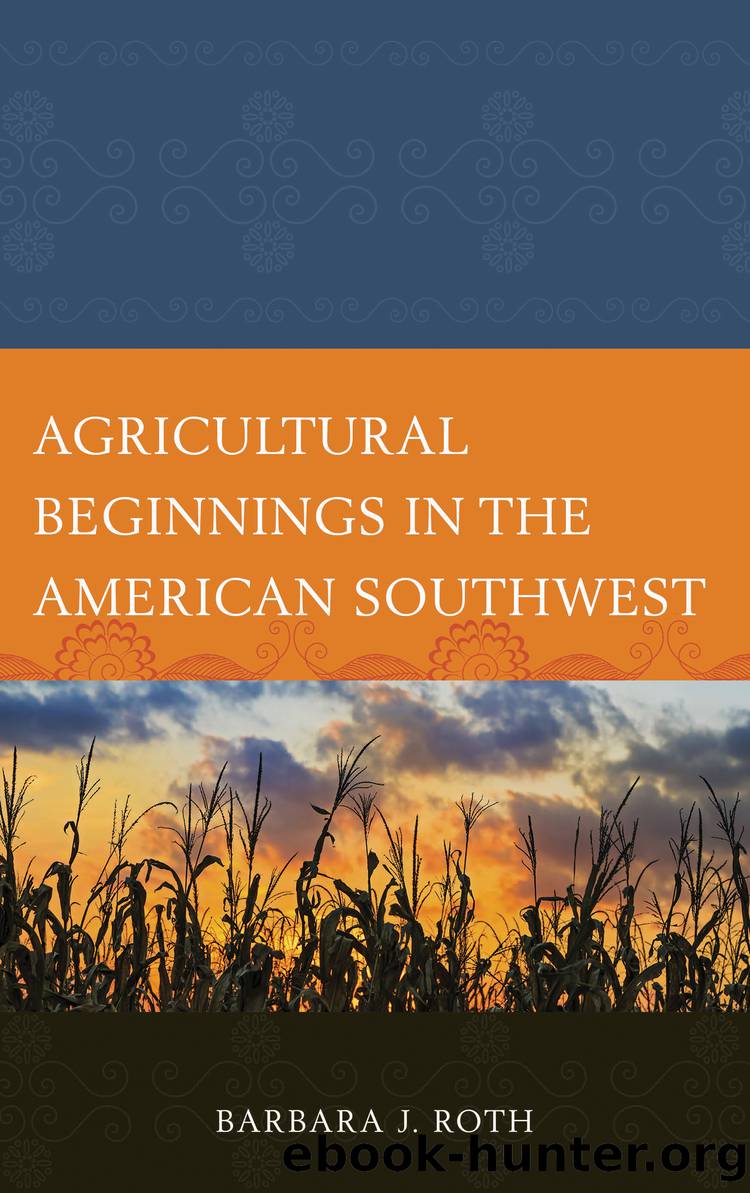Agricultural Beginnings in the American Southwest by Roth Barbara J.;

Author:Roth, Barbara J.; [Roth, Barbara J.]
Language: eng
Format: epub
Publisher: Rowman & Littlefield Unlimited Model
Published: 2016-08-15T00:00:00+00:00
Figure 5.1. Cochise Cultural Sequence as proposed by Sayles and Antevs (1941). Figure by Ben Van Alstyne
Sayles later defined an intervening phase between Sulphur Springs and the later Chiricahua phase that he called the Cazador phase (Sayles 1983). He separated it from Sulphur Springs based on the presence of projectile points in the artifact assemblage; however, further research has not supported the inference that this is a separate phase (Waters 1986), and both Sulphur Springs and Cazador are currently classified under the broader term Early Archaic (Huckell 1996a).
The Chiricahua phase (3500â1500 BC) represents the Middle Archaic period and is perhaps most pertinent to agricultural beginnings, as it is during this time frame that agriculture is first found in the Sonoran and Chihuahuan deserts (see below). This phase has now been subsumed under the more general term âMiddle Archaic periodâ (Huckell 1996a). Sayles and Antevs (1941; Sayles 1983) defined the Chiricahua-phase artifact assemblage as consisting of distinct projectile points with side and basal notching, bifaces, bone tools, and shallow basin metates. They identified several different site types, including base camps and specialized hunting and gathering camps. Further work at Middle Archaic sites has greatly expanded our understanding of this period.
The San Pedro Cochise period, now subsumed under the Late Archaic period, was first identified by Sayles and Antevs (1941), based on their work at both Whitewater Draw and in the Sulphur Springs Valley of southeastern Arizona. They dated this period to 1500 BCâAD 100, again based on geological data (Sayles 1983). San Pedro phase sites were identified primarily based on the presence of distinct San Pedro points, with side-to-corner notching, a triangular blade, and straight base. This point type essentially became the âtype fossilâ used to designate the Late Archaic period in the southern Southwest. The distribution of these points ranges from northern Mexico to north-central Arizona and from central New Mexico to central Arizona, but Sayles and Antevs (1941; Sayles 1983) confined their discussion of the San Pedro Cochise to sites in southeastern Arizona and southwestern New Mexico. Other artifacts associated with San Pedro sites included bifaces, scrapers, deep basin metates, manos, and the initial use of the mortar and pestle, which Sayles (1983) tied to changes in subsistence.
The first use of structures was also documented dating to the San Pedro phase (Sayles 1945). Excavations at Benson 5:10 near Fairbank, Arizona, yielded several shallow oval pits approximately two meters in diameter that Sayles considered to represent houses. Storage pits were also found at the site, which dated to 600â500 BC and were associated with what Sayles (1945) referred to as a âSan Pedro Cochiseâ assemblage. A second site, Benson 8:3, yielded a similar shallow house floor with an internal pit. Because these sites were excavated before the advent of flotation analysis, no subsistence remains were found to allow for the interpretation that they were associated with early agriculture.
The notion of the San Pedro Cochise as representing a specific culture occupying the southern deserts has been pervasive in our
Download
This site does not store any files on its server. We only index and link to content provided by other sites. Please contact the content providers to delete copyright contents if any and email us, we'll remove relevant links or contents immediately.
Chaco's Northern Prodigies : Salmon, Aztec, and the Ascendancy of the Middle San Juan Region after AD 1100 by Paul F. Reed(339)
Law Enforcement Interpersonal Communication and Conflict Management by Brian Douglas Fitch(336)
Digital International Relations by Unknown(333)
Skilled interpersonal communication: Research, theory and practice, Fifth edition by Owen Hargie(317)
Critical Perspectives on Human Security : Rethinking Emancipation and Power in International Relations by David Chandler; Nik Hynek(317)
The Enduring Color Line in U.S. Athletics by Krystal Beamon Chris M. Messer(311)
Evidence-Based Policy Making in Labor Economics by Hamermesh Daniel S.;Nottmeyer Olga K.;Nottmeyer Olga;King Sarah;King Sarah;King Sarah;(280)
EPSO CAST Political affairs EU policies: How to succeed in the selection procedure by Franco Reverte José María(275)
Writing Public Policy - A Practical Guide to Communicating in the Policy Making Process by Catherine F. Smith(256)
Criminological Theory in Context by John Martyn Chamberlain(253)
Threshold Concepts in Women's and Gender Studies by Christie Launius Holly Hassel(251)
Tibeton Yoga Its Secret Doc by Evans-Wentz(250)
Positive Psychology and Spirituality in Counselling and Psychotherapy (Conflict, Ethics, and Spirituality, 12) by unknow(250)
Social Problems, Social Issues, Social Science by James Wright(248)
Rothschild and Early Jewish Colonization in Palestine (Geographical Perspectives on the Human Past) by Ran Aaronsohn(246)
Play in child development and psychotherapy: toward empirically supported practice by Sandra W. Russ(240)
Cognitive Development in Infancy and Childhood (Elements in Child Development) by Mary Gauvain(236)
Latin American Politics and Society by Gerardo L. Munck & Juan Pablo Luna(211)
What Makes a Social Crisis?: The Societalization of Social Problems by Jeffrey C. Alexander(210)
